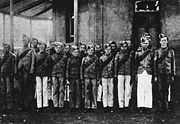
Mafeking Cadet Corps
Encyclopedia

Siege of Mafeking
The Siege of Mafeking was the most famous British action in the Second Boer War. It took place at the town of Mafeking in South Africa over a period of 217 days, from October 1899 to May 1900, and turned Robert Baden-Powell, who went on to found the Scouting Movement, into a national hero...
in South Africa
South Africa
The Republic of South Africa is a country in southern Africa. Located at the southern tip of Africa, it is divided into nine provinces, with of coastline on the Atlantic and Indian oceans...
. They are sometimes seen as forerunners of the Scouts
Scouting
Scouting, also known as the Scout Movement, is a worldwide youth movement with the stated aim of supporting young people in their physical, mental and spiritual development, that they may play constructive roles in society....
, because they were one of Robert Baden-Powell
Robert Baden-Powell, 1st Baron Baden-Powell
Robert Stephenson Smyth Baden-Powell, 1st Baron Baden-Powell, Bt, OM, GCMG, GCVO, KCB , also known as B-P or Lord Baden-Powell, was a lieutenant-general in the British Army, writer, and founder of the Scout Movement....
's inspirations in creating of the Scout movement in 1907.
The siege of Mafeking took place over 217 days during the Second Boer War
Second Boer War
The Second Boer War was fought from 11 October 1899 until 31 May 1902 between the British Empire and the Afrikaans-speaking Dutch settlers of two independent Boer republics, the South African Republic and the Orange Free State...
in 1899-1900. Robert Baden-Powell was the British colonel charged with defending the town. Because of the shortage of manpower in the town, boys were used to support the troops, carry messages, and help in the hospital. This freed up men for military duties, and kept the boys occupied.
The cadets consisted of volunteer white boys below fighting age. Their leader was the 13 year old Warner Goodyear, who became their Sergeant-Major. They were given khaki uniforms and a wide-brimmed hat which they wore with one side turned up, and a Glengarry
Glengarry
The glengarry bonnet is a traditional boat-shaped hat without a peak made of thick-milled woollen material with a toorie on top, a rosette cockade on the left, and ribbons hanging down behind...
cap, and the towns people often commented on their smartness.
Cadet duties
One of the cadets' duties was to carry messages around the town and to outlying forts, sometimes as much as a mile away across open ground. At first they used donkeys, but as the siege ran on, food became scarce and the donkeys ended up in the kitchen. From then on, the cadets used bicycles instead.Another important duty was to act as lookouts, mainly to warn the townspeople when the Boer siege guns were aimed and fired at different parts of the town.
The town produced its own postage stamps, known as "Mafeking Blues", for postage during the siege. The first stamps depicted Baden-Powell, followed by a stamp depicting the cadet leader Warner Goodyear seated on a bicycle http://www.scouting.org.za/seeds/stamp.html. The Mafeking stamps are unusual among the stamps of the British Empire, because they do not depict the monarch.
Frankie Brown, a 9 year old boy, was killed by a shell during the siege, and is sometimes claimed as a cadet casualty, although it is unlikely that he was a cadet. The youngest cadets on the nominal roll were aged 11.
At the end of the siege, 24 Cadets were awarded the Defence of Mafeking bar to the Queen's South Africa Medal.
The first Scouts?
Baden-Powell was impressed by the cadets and used them as an example of bravery in "Campfire yarn number one" in the opening chapter of Scouting for BoysScouting for Boys
Scouting for Boys: A Handbook for Instruction in Good Citizenship is the first book on the Scout Movement, published in 1908. It was written and illustrated by Robert Baden-Powell, its founder...
, the first Scout handbook, which he published in 1908. He relates the following conversation with one of the cadets:
- I said to one of these boys on one occasion, when he came in through rather a heavy fire: 'You will get hit one of these days riding about like that when shells are flying'. And he replied 'I pedal so quick, Sir, they'd never catch me'.
The Mafeking Cadets are sometimes called the first Boy Scouts, although they were not Scouts in the true sense, as they did not take a Scout Promise
Scout Promise
Since the publication of Scouting for Boys in 1908, all Scouts and Guides around the world have taken a Scout promise or oath to live up to ideals of the movement, and subscribed to a Scout Law. The wording of the Scout Promise and Scout Law have varied slightly over time and from country to...
. Scouting was born later, in 1907 at Brownsea Island
Brownsea Island Scout camp
The Brownsea Island Scout camp was a boys camping event on Brownsea Island in Poole Harbour, southern England, organised by Lieutenant-General Baden-Powell to test his ideas for the book Scouting for Boys. Boys from different social backgrounds participated from 1 August to 8 August 1907 in...
in Britain.

